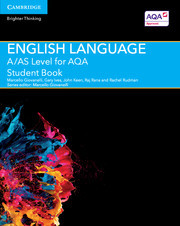Description
A/AS Level English Language for AQA Student Book
A Level (AS) English Language AQA Series
Authors: Ives Gary, Keen John, Rana Raj, Rudman Rachel
Coordinator: Giovanelli Marcello
A new series of bespoke, full-coverage resources developed for the 2015 A Level English qualifications.
Language: English39.30 €
In Print (Delivery period: 14 days).
Add to cart
Publication date: 06-2015
320 p. · 21.9x27.7 cm · Paperback
320 p. · 21.9x27.7 cm · Paperback
Description
/li>Contents
/li>
A new series of bespoke, full-coverage resources developed for the 2015 A Level English qualifications. Endorsed for the AQA A/AS Level English Language specifications for first teaching from 2015, this print Student Book is suitable for all abilities, providing stretch opportunities for the more able and additional scaffolding for those who need it. Helping bridge the gap between GCSE and A Level, the unique three-part structure provides essential knowledge and allows students to develop their skills through a deeper study of key topics, whilst encouraging independent learning. An enhanced digital version and free Teacher's Resource are also available.
Introduction; BEGINNING: 1. What does language study mean at A Level?; 2. Text producers and receivers; 3. Mode and genre; 4. Language use and language users; 5. Language level 1: Lexis and semantics; 6. Language level 2: Grammar; 7. Language level 3: Phonetics, phonology and prosodics; 8. Language level 4: Graphology; 9. Language level 5: Pragmatics; 10. Language level 6: Discourse; 11. Introduction to analysing texts; 12. Becoming a language investigator; DEVELOPING: 13. Textual variations and representations; 13.1 Textual variations; 13.2 Language analysis: methods and approaches; 13.3 Language analysis: genre and mode; 13.4 Language analysis: audience and purpose; 13.5 Introduction to representations; 13.6 Language and representations: people, social groups and gender; 13.7 Language and representations: events, places and issues; 13.8 Exploring similarities and differences between texts; 13.9 Bringing it all together; 14. Child language development; 14.1 Learning to talk; 14.1.1 The process of spoken acquisition; 14.1.2 A historical overview of acquisition theory; 14.1.3 Environmental factors; 14.1.4 Pragmatics; 14.1.5 Discourse; 14.1.6 Lexis and semantics; 14.1.7 Grammar; 14.2 Learning to write; 14.2.1 Early exposure to printed language; 14.2.2 Learning to read; 14.2.3 The process of writing development; 14.2.4 Attitudes and theories about learning to write; 14.2.5 Environmental factors; 14.2.6 Handwriting and orthography; 14.2.7 Lexical and grammatical development; 14.3 Bringing it all together; 15. Language diversity; 15.1 Varieties and diversity – an overview; 15.2 Geographical varieties of English; 15.3 Grammatical variations; 15.4 Phonological variations: our accent; 15.5 Personal and social varieties of English; 15.6 Bringing it all together; 16. Language change; 16.1 Studying language change; 16.2 The origins of English; 16.3 Lexical change; 16.4 Semantic change; 16.5 Orthography; 16.6 Grammatical change; 16.7 Standardisation; 16.8 Why does change happen?; 16.9 How does change spread?; 16.10 Bringing it all together; 17. Language in action: a language investigation; 17.1 What is a language investigation?; 17.2 Choosing an area to investigate; 17.3 What approach could you take?; 17.4 Data collection; 17.5 Data selection; 17.6 Writing your investigation; 17.7 Bringing it all together; 18. Original writing; 18.1 The writing process; 18.2 The style model; 18.3 The power of persuasion; 18.4 The power of storytelling; 18.5 The power of information; 18.6 The drafting process; 18.7 Writing a commentary; 18.8 Referencing your work; 18.9 Bringing it all together; ENRICHING: 19 Textual variations and representations; 20 Language development; 21 Language diversity; 22 Language change; 23 Language investigation; 24 Original writing; References; Index; Acknowledgements
© 2024 LAVOISIER S.A.S.





